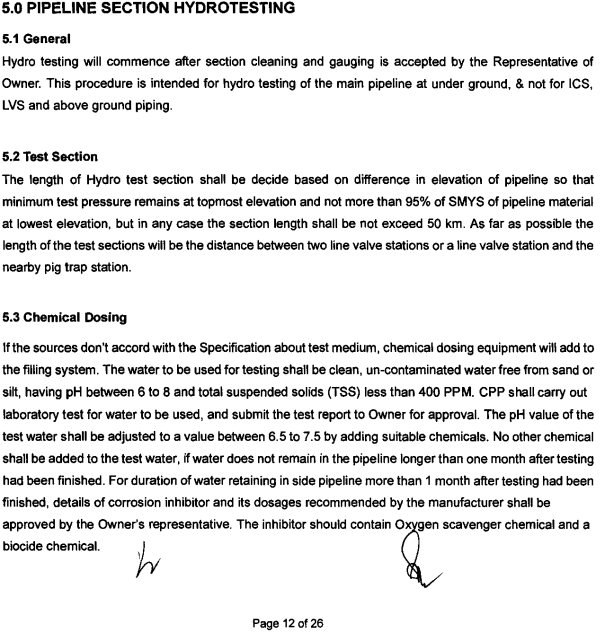Cross country pipeline hydro test
prashant pansare
lakshman kumar
Hi,
Good morning to all,
1. Because of safety parameters HT will be done after back filling – as the pipe passes in public areas also, and keeping the excavated sections to open up to HT is also risk, so there is no other option except to do HT after back filling.
2. Leakage water will come to ground and we can identify – however in water pipe lines – some extent of leakage is acceptable for small leakages (as per CODE), and heavy leakages will be identified by water on the ground.
For oil& Gas, LPG, other services lines so many other options are their to detect(75% of the cases it will be identified in pigging only)
3. Maximum length depends up on service of the line, geographical conditions, site conditions, elevation differences, water availability and disposal situation however maximum length restriction are their in respect codes ex ASME B 31.8 – for oil & gas 50KM is maximum – and this will be given in client spec also.
Thanks and Regards................?
|
|
Lakshman Kumar.B|Manager |Lanco Infratech Limited Plot No 1255 | Sanjeevani chowk | Mahanadi vihar | Cuttack 753004 Phone : + 91 671 2445033 | Mobile : +91 9937286851 |www.lancogroup.com Go Green|The future will thank you |
--
To post to this group, send email to material...@googlegroups.com
To unsubscribe from this group, send email to
materials-weld...@googlegroups.com
For more options, visit this group's bolg at http://materials-welding.blogspot.com/
The views expressed/exchnaged in this group are members personel views and
meant for educational purposes only, Users must take their own decisions w.r.t.
applicable code/standard/contract documents.
bele...@gmail.com
Lakshman Kumar B
Hi,
Please note a small correction in my earlier mail…
As stated by you there is no restriction of length as per B31.8, - your statement and understanding is correct.
In one of my previous project we had a limitation of 50KM and the same I shared at here.
However in general doing 50KM at a single stretch is a big challenge and other parameters may not support too (particularly in INDIA)
If your project specs are permitting you can do the hydro test more than 50KM also, no code restrict’ s you…

Thanks & Regards,
Lakshman Kumar B,
The views expressed/exchnaged in this group are members personel views and meant for educational purposes only, Users must take their own decisions w.r.t. applicable code/standard/contract documents.
---
You received this message because you are subscribed to the Google Groups "Materials & Welding" group.
To unsubscribe from this group and stop receiving emails from it, send an email to materials-weld...@googlegroups.com.
To post to this group, send email to material...@googlegroups.com.
To view this discussion on the web visit https://groups.google.com/d/msgid/materials-welding/ed4944f9-cb42-463e-ab9c-83d0c6f87c1d%40googlegroups.com.
For more options, visit https://groups.google.com/d/optout.
rajeev arora
Section length also decide based on confirmation of pig manufacturer and pressure difference at high and low point or maximum and minimum
To unsubscribe from this group and stop receiving emails from it, send an email to materials-welding+unsubscribe@googlegroups.com.
To post to this group, send email to materials-welding@googlegroups.com.
To view this discussion on the web visit https://groups.google.com/d/msgid/materials-welding/ed4944f9-cb42-463e-ab9c-83d0c6f87c1d%40googlegroups.com.
For more options, visit https://groups.google.com/d/optout.
--
http://www.linkedin.com/groups/MaterialsWelding-122787?home=&gid=122787&trk=anet_ug_hm
The views expressed/exchnaged in this group are members personel views and meant for educational purposes only, Users must take their own decisions w.r.t. applicable code/standard/contract documents.
---
You received this message because you are subscribed to the Google Groups "Materials & Welding" group.
To unsubscribe from this group and stop receiving emails from it, send an email to materials-welding+unsubscribe@googlegroups.com.
To post to this group, send email to materials-welding@googlegroups.com.
To view this discussion on the web visit https://groups.google.com/d/msgid/materials-welding/014701d27933%2488f7cd40%249ae767c0%24%40gmail.com.
